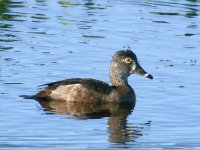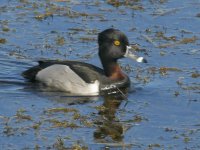What do I have here? I know it is a Ring-necked Duck, but it does not look like either the male or female. Is it a Juvenile? The photograph was taken in late February which is in the middle of the mating season for them so it should not be molting. Location, Viera Wetlands in east, central Florida.
Took a closer look. Only the female has an eye-ring. So, this may be just a female that the head is a little darker than normal.
Took a closer look. Only the female has an eye-ring. So, this may be just a female that the head is a little darker than normal.
Attachments
Last edited:





